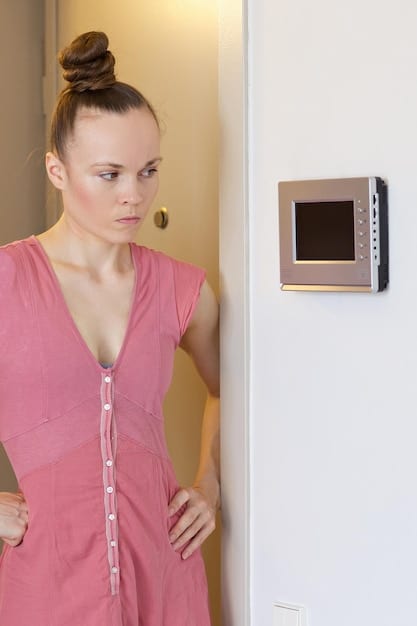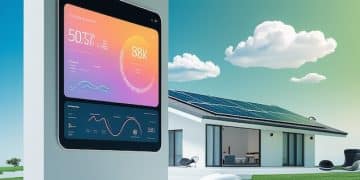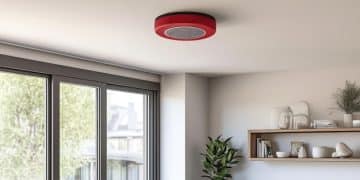Automated Blinds: Glare Reduction & Energy Savings in US Homes

Anúncios
Automated blinds offer a cutting-edge solution for managing natural light and enhancing energy efficiency in United States homes by dynamically adjusting to environmental conditions, thereby reducing glare and optimizing indoor temperatures.
In the evolving landscape of smart home technology, automated blinds stand out as a revolutionary yet practical innovation for residents across the United States. These intelligent window coverings go beyond mere aesthetics, offering tangible benefits that directly impact comfort, energy consumption, and overall home efficiency. From mitigating harsh sunlight to maintaining optimal indoor temperatures, automated blinds are transforming how we interact with our living spaces, ushering in an era where convenience meets sustainability.
The Rise of Automated Blinds in US Homes
Automated blinds are rapidly gaining traction in US homes, moving from a niche luxury product to a mainstream smart home staple. Their increasing popularity is directly linked to the growing desire for enhanced comfort, greater energy efficiency, and seamless integration with existing smart home ecosystems. These systems offer unparalleled convenience, allowing homeowners to control natural light with the touch of a button or through voice commands, or even autonomously based on pre-set schedules or environmental conditions.
Why Homeowners Are Choosing Automation
The primary drivers behind the adoption of automated blinds are multifaceted. Homeowners are seeking solutions that simplify daily tasks while simultaneously delivering measurable benefits. The ability to manage sunlight and privacy without physical effort, especially in homes with numerous or hard-to-reach windows, is a significant draw. Furthermore, the aesthetic appeal of a clutter-free window sill, devoid of dangling cords, contributes to a cleaner, more modern interior design.
- Convenience: Control blinds from anywhere, whether at home or away, using a smartphone, remote, or voice assistant.
- Safety: Cordless operation eliminates potential hazards for children and pets.
- Aesthetics: Provides a sleek, modern look, enhancing the home’s interior design.
- Home Security: The ability to program blinds to open and close can create the illusion of occupancy, deterring potential intruders.
Beyond these immediate benefits, automated blinds present a compelling case for improved quality of life. Imagine waking up to blinds that slowly open, letting in the morning light naturally, or having them silently close at dusk for instant privacy. This level of personalized control over one’s environment greatly contributes to a more comfortable and well-regulated living space. The investment, while initially higher than traditional blinds, often pays for itself through energy savings and enhanced property value, making them a wise long-term choice for discerning homeowners in the US.
The integration with smart home assistant like Amazon Alexa or Google Assistant allows for sophisticated routines, where blinds work in harmony with lighting, thermostats, and security systems. This interconnectedness creates a truly intelligent home environment, optimizing various aspects of daily living. The seamless user experience and the robust, reliable performance of modern automated systems make them an increasingly attractive upgrade for any American household looking to embrace the future of home automation.
Finally, the customizable nature of automated blind systems means they can be tailored to fit almost any window size or shape, from standard windows to large patio doors and skylights. This versatility ensures that even unique architectural features can benefit from smart light management. The wide array of fabric choices and styles available also means that functionality does not come at the expense of design, allowing homeowners to perfectly match their blinds to their home’s decor.
Battling Glare with Smart Technology
One of the most immediate and noticeable benefits of automated blinds is their exceptional ability to combat excessive glare. Sunlight, while essential, can be disruptive when it intensifies, causing uncomfortable reflections on screens, harsh brightness in living areas, and even eye strain. Traditional blinds require constant manual adjustment, a tedious and often neglected task. Automated systems, however, offer dynamic and intelligent solutions to this common household problem, ensuring optimal light conditions throughout the day.
Automated blinds leverage sophisticated sensors and programming capabilities to react to changing light conditions seamlessly. This proactive approach minimizes glare before it becomes an issue, creating a consistently comfortable environment. Imagine a bright afternoon where the sun shifts, and your blinds automatically tilt or lower slightly to block the direct rays without plunging the room into darkness. This level of responsiveness is virtually impossible to achieve with manual operation.
How Automated Blinds Minimize Glare
The intelligence of these systems often lies in their integration with light sensors or pre-set astronomical clocks. Some advanced systems can even connect to local weather forecasts, anticipating bright conditions before they arrive. This foresight allows for a more subtle and effective glare reduction, as adjustments are made incrementally rather than reactively.
- Light Sensors: Detect ambient light levels and trigger blinds to adjust accordingly, dimming when sunlight is too strong.
- Time-Based Scheduling: Program blinds to adjust based on sunrise and sunset times, or specific hours of the day.
- Scene Control: Create pre-set “scenes” for different activities (e.g., “Movie Night” dims blinds and lights) that can be activated instantly.
- Voice Control Integration: Adjust blinds by simply speaking a command, making immediate glare reduction effortless.
Beyond automated adjustments, the materials used in smart blinds also play a crucial role in glare management. Many automated blinds come with specialized fabrics that diffuse light, turning harsh beams into soft, ambient illumination. These materials are designed to block UV rays while still allowing natural light to filter through, protecting furniture and flooring from fading without sacrificing brightness.
The ability to maintain a consistent level of diffused light throughout the day is particularly beneficial for home offices and media rooms, where screen visibility is paramount. By preventing sharp contrasts, automated blinds reduce eye fatigue and enhance the overall comfort of these spaces. The proactive nature of these systems means that homeowners can enjoy their activities without constant interruptions from glaring sunlight, contributing to a more productive and enjoyable environment.
Ultimately, the investment in automated blinds for glare reduction is an investment in comfort and well-being. It transforms a common household annoyance into a seamless, automated process, allowing residents to fully enjoy their indoor spaces without compromising on natural light or succumbing to its harsh effects. This intelligent management of light sets a new standard for home comfort, making daily life easier and more pleasant.

Energy Savings Through Smart Window Management
Beyond comfort and convenience, one of the most compelling reasons for US homeowners to invest in automated blinds is the significant potential for energy savings. Windows are often a primary source of heat loss in winter and heat gain in summer, directly impacting the load on HVAC systems. Automated blinds, when properly utilized, can act as a dynamic thermal barrier, reducing energy consumption and leading to lower utility bills.
The principle is simple: by intelligently managing the amount of sunlight entering a home, automated blinds can help maintain more stable indoor temperatures. In warmer months, they can block excessive solar heat gain, reducing the need for air conditioning. During colder periods, they can be programmed to maximize passive solar heating when desired and then provide additional insulation at night, lessening reliance on artificial heating.
Optimizing Temperature Regulation
The key to energy efficiency with automated blinds lies in their ability to adapt to real-time conditions rather than remaining static. Manual adjustments are often forgotten or inconvenient, but automated systems ensure that blinds are always in the optimal position for thermal performance. This intelligent functionality contributes directly to significant reductions in heating and cooling costs over time.
- Seasonal Programming: Configure blinds to open during winter mornings for solar gain and close on summer afternoons to block heat.
- Temperature Sensor Integration: Link blinds to a smart thermostat or dedicated temperature sensor to auto-adjust when rooms get too hot or cold.
- UV Protection: Fabrics that block harmful UV rays also help reduce heat transfer, preserving indoor temperatures and protecting furnishings.
- Smart Home Ecosystems: Integrating blinds with other smart devices allows for a holistic approach to energy management, ensuring all systems work in harmony.
Consider a typical summer day in the US, where afternoon sun can dramatically raise indoor temperatures. With automated blinds, as soon as the sun hits a certain intensity or angle, the blinds can automatically lower or adjust their slats, proactively preventing the heat from penetrating. This reduces the strain on your air conditioning unit, potentially by a noticeable margin. Conversely, on a cold winter morning, the blinds can be programmed to open wide, allowing the sun’s warmth to naturally pre-heat rooms, reducing the need for the furnace to work as hard.
Furthermore, many automated blinds are designed with insulating properties. Layered fabrics, honeycomb structures, or even motorization that ensures a tight fit within the window frame can add an extra layer of thermal resistance. This is particularly beneficial at night or on cloudy days when external temperatures are extreme, providing an additional barrier against heat escaping or entering.
The long-term financial benefits of energy efficiency can be substantial. While the initial investment in automated blinds may be higher than traditional options, the cumulative savings on utility bills can offset this cost over several years. Moreover, homeowners are increasingly conscious of their carbon footprint, and automated blinds offer a tangible way to reduce energy consumption and contribute to a more sustainable lifestyle. This blend of comfort, convenience, and environmental responsibility makes automated blinds an increasingly attractive and practical upgrade for US homes.
Advanced Features and Smart Home Integration
The true power of automated blinds lies not just in their core functionality but in their advanced features and seamless integration capabilities with broader smart home ecosystems. These modern systems go far beyond simple remote control, offering sophisticated ways to manage light, privacy, and energy efficiency through intelligent automation. Understanding these features is key to unlocking the full potential of automated blinds in your US home.
One of the most compelling aspects is the ability to create personalized schedules and scenes. Instead of relying on manual adjustments, homeowners can program their blinds to operate autonomously based on specific times of day, days of the week, or even seasonal changes. This “set it and forget it” convenience ensures that your home always has optimal lighting and privacy, even when you’re not there.
Seamless Connectivity with Smart Home Hubs
For a truly integrated smart home experience, automated blinds can connect to popular platforms like Amazon Alexa, Google Assistant, Apple HomeKit, and Samsung SmartThings. This connectivity allows for centralized control and the creation of complex routines that involve multiple devices working in harmony. Imagine saying “Good morning,” and your blinds open, lights gradually turn on, and your coffee maker starts brewing.
- Voice Control: Operate blinds effortlessly using voice commands through smart speakers or phones.
- Geofencing: Program blinds to close when you leave home and open when you return, enhancing security and privacy.
- Routines and Scenes: Create custom scenarios that adjust blinds, lighting, temperature, and other smart devices simultaneously.
- Weather Integration: Some systems can access local weather data to adjust blinds proactively before a storm or intensely sunny period.
Beyond basic scheduling, many automated blind systems incorporate sensors that greatly enhance their intelligence. Light sensors can detect the intensity of incoming sunlight and automatically adjust the blinds to reduce glare or maximize natural light. Temperature sensors can trigger adjustments to help maintain optimal indoor climate, contributing to energy savings. Wind sensors can even retract outdoor shades or awnings to prevent damage during strong gusts.
The ability to control blinds remotely via a smartphone app provides peace of mind and convenience. Whether you’re at work, on vacation, or simply in another room, you can check the status of your blinds and make adjustments as needed. This feature is particularly useful for security, allowing you to create the illusion of occupancy when you’re away, or to quickly close blinds if a sudden downpour moves in.
Furthermore, advanced automated blinds often include features like “favored positions,” allowing you to save specific open/close or tilt settings that you can recall with a single tap. This level of customization ensures that your blinds always align with your desired aesthetic and functional needs. The continuous innovation in this space means that automated blinds are becoming an increasingly sophisticated and indispensable component of the modern smart home.
Installation and Maintenance Considerations
When considering automated blinds for your US home, understanding the installation process and ongoing maintenance requirements is crucial. While the benefits are clear, ensuring a smooth setup and proper care will guarantee years of trouble-free operation and maximize your investment. The complexity of installation can vary significantly based on the type of automation and the existing window infrastructure.
For basic battery-powered systems, installation might be straightforward enough for a DIY enthusiast. These often involve mounting brackets and simply clicking the blind into place. However, for hardwired systems or those integrating with complex smart home hubs, professional installation is highly recommended to ensure correct wiring, secure mounting, and seamless system integration.
Choosing the Right Installation Method
The choice between DIY and professional installation often comes down to comfort level with tools and electrical work, as well as the specific features of the automated blinds. Consulting with a reputable dealer or installer can help determine the best approach for your home. They can also advise on necessary adjustments to window frames or electrical outlets, if required.
- DIY (Do It Yourself): Best for simple, battery-powered systems with clear instructions. Requires basic tools and some technical aptitude.
- Professional Installation: Recommended for hardwired systems, complex integrations, large or multiple window installations, and custom solutions. Ensures proper functioning and warranty preservation.
- Measurement Accuracy: Crucial for both DIY and professional installs; precise measurements are essential for a perfect fit and optimal operation.
- Power Source: Consider battery-powered (easier install, battery changes), plug-in (requires nearby outlet), or hardwired (cleanest look, no battery changes) options.
Once installed, automated blinds generally require minimal maintenance. The motors are typically designed for long-term reliability and silent operation. The primary ongoing task will be battery replacement for battery-powered units, which usually occurs every 6-12 months depending on usage. Hardwired and solar-powered options eliminate this need, offering greater convenience.
Cleaning automated blinds is similar to traditional ones, focusing on gentle dusting or vacuuming with a brush attachment. It’s important to avoid harsh chemicals or excessive moisture, especially near motor components, to prevent damage. Regular, light cleaning will help maintain their appearance and extend their lifespan.
For any smart home device, software updates are also a consideration. Most automated blind systems’ apps will prompt you for updates that improve performance, add features, or enhance security. Keeping the software up to date ensures your system operates at its best. In case of issues, troubleshooting typically involves checking power sources, connectivity, and recalibrating the blinds through the app or remote. Most manufacturers provide excellent online support and user manuals.
Ultimately, proper installation by skilled professionals, combined with adherence to manufacturer-recommended maintenance, will ensure that your automated blinds provide years of reliable service, enhancing comfort, security, and energy efficiency in your US home without significant ongoing effort. This attention to detail from initial setup onwards is key to a satisfying smart home experience.
Cost-Benefit Analysis for US Homeowners
Investing in automated blinds represents a significant decision for many US homeowners, and a thorough cost-benefit analysis is essential to understand the potential return on investment. While the upfront cost of automated blinds is generally higher than their manual counterparts, the long-term benefits in terms of energy savings, enhanced comfort, security, and increased property value often justify the initial expenditure.
The pricing for automated blinds can vary widely, influenced by factors such as the type of blind (e.g., roller, Roman, Venetian), material quality, motorization system (battery, wired, solar), brand reputation, and the level of smart home integration. Custom-sized or specialized window treatments will also add to the cost. However, it’s important to look beyond the sticker price and consider the cumulative advantages.
Weighing the Upfront Cost Against Long-Term Gains
The most tangible financial benefit comes from energy efficiency. As previously discussed, automated blinds can significantly reduce heating and cooling loads by intelligently managing solar heat gain and loss. This translates directly into lower utility bills, which can add up substantially over the course of a year, especially in regions with extreme climates.
- Initial Investment: Higher than manual blinds due to motorization, sensors, and smart tech integration.
- Energy Savings: Potential 10-20% reduction in HVAC costs, varying by climate, home insulation, and usage patterns.
- Increased Property Value: Smart home features, including automated blinds, are increasingly attractive to potential buyers, adding appraisal value.
- Tax Credits/Rebates: In some areas, energy-efficient home improvements may qualify for local or federal incentives.
Beyond direct financial savings, the enhanced quality of life is a significant, albeit less quantifiable, benefit. The convenience of voice control or scheduled adjustments, the improved comfort from reduced glare, and the added layer of security contribute to a more enjoyable and stress-free home environment. These elements improve daily living and are often cited by homeowners as major factors in their satisfaction with smart home upgrades.
From a long-term perspective, automated blinds can also add value to your property. Smart home technology is a desirable feature for modern homebuyers, signaling a well-maintained and technologically savvy home. This can make your home more appealing and potentially command a higher selling price in the future. Moreover, the durability of modern motorization systems means these blinds are a long-lasting investment, typically outperforming simpler manual options in terms of longevity.
Finally, while difficult to put a precise dollar value on, the increased safety (due to cordless operation) and the peace of mind offered by remote control capabilities contribute to the overall value proposition. The ability to simulate occupancy while away or instantly adjust blinds for privacy offers a level of control and security that traditional blinds cannot match. When considering all these factors, automated blinds emerge not just as a luxury, but as a smart, energy-efficient, and value-adding upgrade for any US home.
Future Trends in Automated Window Coverings
The landscape of automated window coverings is continuously evolving, driven by advancements in smart technology, sensor integration, and a growing consumer demand for more intuitive and energy-efficient home solutions. In the US, we can expect to see several exciting trends emerge in the coming years, further enhancing the capabilities and accessibility of automated blinds. These innovations promise to make our homes not just smarter, but truly more responsive to our needs and the environment.
One major trend is the ongoing miniaturization and efficiency of motors, leading to even quieter and more compact designs. This allows for lighter-weight blinds and opens up possibilities for integrating automation into an even wider variety of window treatment styles, including those with delicate fabrics or intricate designs. The focus will remain on seamless integration, making the automation virtually invisible.
Smarter Integration and Sustainability
The future will also bring even more sophisticated AI and machine learning capabilities to automated blinds. Imagine blinds that not only react to light and temperature but learn your preferences over time, anticipating your needs and adjusting proactively. For instance, if you consistently close your living room blinds at 4 PM to avoid the setting sun, the system might learn this pattern and automatically initiate it without requiring manual setup.
- Predictive Automation: AI-powered systems learning user habits and anticipating environmental changes to optimize adjustments.
- Self-Charging & Off-Grid Options: Increased reliance on solar power and kinetic energy harvesting to eliminate battery changes and wiring needs.
- Enhanced Material Science: Development of fabrics with dynamic light filtering or privacy-on-demand capabilities.
- Interoperability Dominance: Even broader compatibility with diverse smart home platforms, ensuring seamless integration regardless of chosen ecosystem.
Another significant direction is towards greater energy independence for the blinds themselves. While solar-powered options exist, future designs may incorporate more advanced energy harvesting technologies, making battery changes obsolete for even more models. This not only reduces maintenance but also aligns with the broader push towards sustainable home technology. The goal is a truly “set and forget” system that is self-sufficient.
Furthermore, we can anticipate advancements in material science that will lead to blinds with even more dynamic properties. This could include smart glass technologies or fabrics that can change their opacity or color on demand, offering unprecedented control over light and privacy without mechanical movement. Such innovations would blur the lines between window treatments and the windows themselves.
Finally, the trend towards greater interoperability will continue. As smart home ecosystems mature, automated blinds will communicate more effectively with other devices, creating truly holistic home automation. This means a single command or automated routine could manage climate control, lighting, security, and window coverings in perfect synchronization. The future of automated blinds in US homes is undoubtedly one of increased intelligence, sustainability, and effortless control, making our living spaces more comfortable, efficient, and responsive than ever before.
Choosing the Right Automated Blinds for Your Home
Selecting the perfect automated blinds for your US home involves more than just aesthetics; it requires a thoughtful consideration of various factors to ensure they meet your specific needs for glare reduction, energy savings, and integration with your lifestyle. Making an informed decision will lead to satisfaction and maximize the benefits these advanced window coverings offer.
Begin by assessing the primary purpose of the blinds in each room. Is it glare reduction for a home office, privacy for a bedroom, or energy efficiency for a south-facing living room? Different types of blinds and fabric opacities excel at different tasks. For instance, solar shades are excellent for maintaining views while blocking heat and glare, whereas blackout blinds are ideal for bedrooms.
Key Factors in Your Decision
Consider the power source that best suits your home and preferences. Battery-powered options offer the easiest installation without needing electrical work, though batteries will need periodic replacement. Hardwired systems provide a clean, permanent solution but require professional installation. Solar-powered blinds leverage natural light to charge, offering a sustainable, low-maintenance choice, especially for windows with ample sunlight.
- Blind Type & Style: Roller, Roman, cellular, Venetian, or vertical – each offers different aesthetic and functional benefits.
- Fabric Opacity: Sheer, light-filtering, or blackout – choose based on desired privacy and light control.
- Control Options: Remote, wall switch, smartphone app, voice control, or sensor-based automation.
- Smart Home Ecosystem: Ensure compatibility with existing or planned smart home hubs (e.g., Alexa, Google Home).
Compatibility with your existing or planned smart home ecosystem is another critical factor. If you already use an Amazon Echo or Google Home, ensure the blinds you choose can integrate seamlessly. This allows for centralized control and the creation of custom routines involving other smart devices, enhancing convenience and automation.
Budget is, of course, a practical consideration. While automated blinds require an upfront investment, remember to factor in potential long-term energy savings and increased property value. It’s often worthwhile to invest in quality products from reputable brands that offer good warranties and customer support. Professional measurement and installation can prevent costly mistakes and ensure optimal performance.
Finally, don’t overlook professional advice. Reputable blind retailers often have experts who can walk you through the options, provide precise measurements, and recommend the best solutions tailored to your windows and lifestyle. They can also provide insights into specific product features, maintenance, and the overall installation process. By carefully considering these factors, US homeowners can confidently choose automated blinds that transform their living spaces into models of comfort, efficiency, and modern sophistication.

| Key Benefit | Brief Description |
|---|---|
| 💡 Glare Reduction | Automated adjustment to sunlight prevents harsh reflections and eye strain on screens. |
| 💰 Energy Savings | Manages indoor temperatures, reducing HVAC load and lowering utility bills year-round. |
| 🏡 Smart Home Integration | Connects with voice assistants & smart hubs for seamless, unified home control. |
| ✨ Enhanced Comfort & Security | Automated schedules offer privacy and simulate occupancy, boosting peace of mind. |
Frequently Asked Questions About Automated Blinds
Automated blinds reduce glare by automatically adjusting their position or slat angle based on sunlight intensity, time of day, or user-defined schedules. Many systems use light sensors to detect harsh glares and make subtle, proactive adjustments, ensuring a comfortable visual environment without manual intervention. This dynamic control prevents direct sunlight from impacting screens or causing discomfort.
Automated blinds contribute to energy savings by managing solar heat gain and loss. In summer, they can block incoming heat, reducing air conditioning use. In winter, they can harness passive solar heating during the day and insulate at night, lessening heating demands. This intelligent temperature regulation optimizes HVAC system operation, leading to lower utility bills year-round for homeowners.
Installation difficulty varies. Battery-powered automated blinds are generally simple for DIY installation, requiring basic tools. Hardwired systems, however, may necessitate professional electrical work for clean integration and optimal performance. For complex smart home setups or numerous windows, professional installation is often recommended to ensure seamless functionality and warranty compliance, making the process smoother.
Yes, most modern automated blinds are designed for seamless integration with popular smart home systems like Amazon Alexa, Google Assistant, Apple HomeKit, and Samsung SmartThings. This allows for centralized control via voice commands or smartphone apps. Integration enables advanced features, such as creating custom routines that synchronize blinds with lighting, thermostats, and security systems for a truly automated home environment.
Automated blinds generally have a long lifespan, with motors designed for durability and quiet operation. Maintenance is typically minimal, often limited to periodic battery replacements for battery-powered units (every 6-12 months). Cleaning is similar to traditional blinds, requiring gentle dusting or vacuuming. Keeping software updated through the app ensures optimal performance and access to new features, contributing to their longevity and reliability.
Conclusion
Automated blinds represent a significant leap forward in home technology for US homeowners, offering a multifaceted approach to enhancing living spaces. By intelligently managing natural light, they not only effectively reduce disruptive glare but also play a pivotal role in optimizing energy consumption, leading to tangible savings on utility bills. Beyond these practical benefits, their seamless integration with smart home ecosystems provides unparalleled convenience, allowing for effortless control and personalized automation that adapts to your lifestyle. The initial investment is often outweighed by the long-term advantages in comfort, security, and potential property value appreciation. As technology continues to advance, automated blinds are set to become an even more indispensable component of the modern, efficient, and comfortable American home, truly transforming how we experience our indoor environments.





